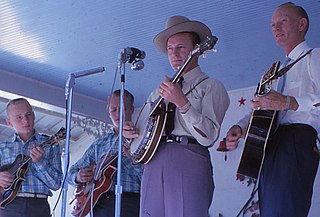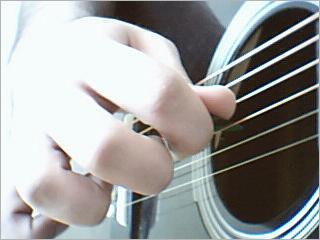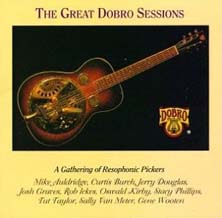The banjo is a stringed instrument with a thin membrane stretched over a frame or cavity to form a resonator. The membrane is typically circular, in modern forms usually made of plastic, originally of animal skin. Early forms of the instrument were fashioned by African Americans and had African antecedents. In the 19th century, interest in the instrument was spread across the United States and United Kingdom by traveling shows of the 19th century minstrel show fad, followed by mass-production and mail-order sales, including instruction method books. The inexpensive or home-made banjo remained part of rural folk culture, but 5-string and 4-string banjos also became popular for home parlor music entertainment, college music clubs, and early 20th century jazz bands. By the early 21st century, the banjo was most frequently associated with folk, bluegrass and country music, but was also used in some rock, pop and even hip-hop music. Among rock bands, The Eagles, Led Zeppelin, and The Grateful Dead have used the five-string banjo in some of their songs.

William Smith Monroe was an American mandolinist, singer, and songwriter, who created the bluegrass music genre. Because of this, he is often called the "Father of Bluegrass".

Bluegrass music is a genre of American roots music that developed in the 1940s in the Appalachian region of the United States. The genre derives its name from the band Bill Monroe and the Blue Grass Boys. Like mainstream country music, it largely developed out of old-time string music, though in contrast, bluegrass is traditionally played exclusively on acoustic instruments and also has roots in traditional English, Scottish, and Irish ballads and dance tunes as well as in blues and jazz. Bluegrass was further developed by musicians who played with Monroe, including 5-string banjo player Earl Scruggs and guitarist Lester Flatt. Monroe characterized the genre as, "Scottish bagpipes and ole-time fiddlin'. It's a part of Methodist, Holiness and Baptist traditions. It's blues and jazz, and it has a high lonesome sound."

Earl Eugene Scruggs was an American musician noted for popularizing a three-finger banjo picking style, now called "Scruggs style", which is a defining characteristic of bluegrass music. His three-finger style of playing was radically different from the traditional way the five-string banjo had previously been played. This new style of playing became popular and elevated the banjo from its previous role as a background rhythm instrument to featured solo status. He popularized the instrument across several genres of music.

Clawhammer, sometimes called down-picking, overhand, or frailing, is a distinctive banjo playing style and a common component of American old-time music.

Old-time music is a genre of North American folk music. It developed along with various North American folk dances, such as square dancing, clogging, and buck dancing. It is played on acoustic instruments, generally centering on a combination of fiddle and plucked string instruments, most often the banjo, guitar, and mandolin. The genre is considered a precursor to modern country music.

Flatt and Scruggs were an American bluegrass duo. Singer and guitarist Lester Flatt and banjo player Earl Scruggs, both of whom had been members of Bill Monroe's band, the Bluegrass Boys, from 1945 to 1948, formed the duo in 1948. Flatt and Scruggs are viewed by music historians as one of the premier bluegrass groups in the history of the genre.
The Keith style of playing the 5-string banjo emphasizes the melody of the song. Also known as the "Melodic" or "Chromatic style", it was first developed and popularized independently by Bobby Thompson and Bill Keith in the early 1960s. It is used primarily by bluegrass banjoists, though it can be applied to virtually any genre. Most banjoists who play Keith style do not use it exclusively, but integrate it as one aspect of their playing, a way of adding spice to the more common 3-finger style of Earl Scruggs.

Donald Wesley Reno was an American bluegrass and country musician, best known as a pioneering banjo and guitar player who partnered with Red Smiley, and later with guitarist Bill Harrell.

Flatpicking is the technique of striking the strings of a guitar with a pick held between the thumb and one or two fingers. It can be contrasted to fingerstyle guitar, which is playing with individual fingers, with or without wearing fingerpicks. While the use of a plectrum is common in many musical traditions, the exact term "flatpicking" is most commonly associated with Appalachian music of the American southeastern highlands, especially bluegrass music, where string bands often feature musicians playing a variety of styles, both fingerpicking and flatpicking. Musicians who use a flat pick in other genres such as rock and jazz are not commonly described as flatpickers or even plectrum guitarists. As the use of a pick in those traditions is commonplace, generally only guitarists who play without a pick are noted by the term "fingerpicking" or "fingerstyle".
Josh Graves, born Burkett Howard Graves, was an American bluegrass musician. Also known by the nicknames "Buck," and "Uncle Josh," he is credited with introducing the resonator guitar into bluegrass music shortly after joining Lester Flatt, Earl Scruggs and the Foggy Mountain Boys in 1955. He was inducted into the International Bluegrass Music Hall of Honor in 1997.
Traditional bluegrass, as the name implies, emphasizes the traditional elements of bluegrass music, and stands in contrast to progressive bluegrass. Traditional bluegrass musicians play folk songs, tunes with simple traditional chord progressions, and on acoustic instruments of a type that were played by bluegrass pioneer Bill Monroe and his Blue Grass Boys band in the late 1940s. Traditional bands may use their instruments in slightly different ways, for example by using multiple guitars or fiddles in a band.

The Great Dobro Sessions is a 1994 country music and bluegrass album featuring an all-star line-up of 10 American resonator guitar players, produced by dobro players Jerry Douglas and Tut Taylor.
DeWitt "Snuffy" Jenkins was an American old time banjo player and an early proponent of the three-finger banjo style.
Allen Shelton was an American five-string banjo player mostly known for being a member of the bluegrass band Jim & Jesse and the Virginia Boys since the 1960s. Shelton was born in Rockingham County, North Carolina, on July 2, 1936. Shelton started playing the banjo when he was fourteen. His father Troy Shelton was a guitar player mainly, but also played mandolin and banjo. A local musician named Junior Biggs showed him some three-finger style rolls.

Carter Family picking, also known as the thumb brush, the Carter lick, the church lick, or the Carter scratch, is a style of fingerstyle guitar named after Maybelle Carter of the Carter Family. It is a distinctive style of rhythm guitar in which the melody is played on the bass strings, usually low E, A, and D while rhythm strumming continues above, on the treble strings, G, B, and high E. This often occurs during the break. The style bears similarity to the frailing style of banjo playing and is the rhythm Bill Monroe adapted for bluegrass music two decades later.

In bluegrass music, a banjo roll or roll is a pattern played by the banjo that uses a repeating eighth-note arpeggio – a broken chord – that by subdividing the beat 'keeps time'. "Each ["standard"] roll pattern is a right hand fingering pattern, consisting of eight (eighth) notes, which can be played while holding any chord position with the left hand."
Benjamin Horace Williams was an American bluegrass musician. A multi-instrumentalist, he sang and played fiddle, guitar, banjo, autoharp, and mandolin.

Bluegrass mandolin is a style of mandolin playing most commonly heard in bluegrass bands.
Banjo music is a genre of music that consists exclusively, or primarily of, the banjo. Banjo music can be played as a solo, or it can be played with a band. Banjo music can be played with all types of banjos.














